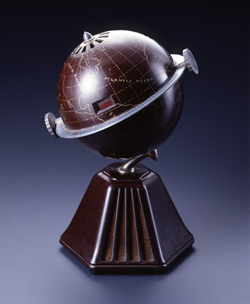
Outline

From March to May, 2010, The International Design Museum is holding an exhibition titled American Designers of the 30s: First Generation Designers. This is the 15th exhibition in the Design Museum Collection Series, showcasing its examples of American Art Deco. During a period when the occupation of “designer” had only just begun to be recognized, in the United States, that occupation was both acknowledged and widely valued. In the 1930s, design was a new occupation, and a new role, born in a country that began to develop as an economic power following World War I. The pioneers of that occupation, most active in industrial design, created work that made maximum use of new techniques and materials, and fulfilled a great role in the Depression-wracked US economy. This exhibit introduces the work of those who were recognized as the first generation of designers.
Design Museum Collection Series Vol. 15
American Designers of the 30s
From the end of the 19th Century through the beginning of the 20th, in Europe and the United States, both of which experienced the Industrial Revolution and the development of industrialized societies, certain people advocated the necessity of uniting art and technology. Most of these individuals came from the field of fine arts, with their ideology springing from a dissatisfaction and sense of crisis about what they considered inelegant manufactured products. Because at the time the people responsible for product development (including styling) were either the product planners of the technicians or craftspeople making the products, there were manufactured a great number of products that were far from beautiful. In addition, the United States was an emerging nation that had taken advantage of World War I to increase its power and it exhibited little resistance to science and mechanical technology, resulting in the production of an abundance of awkward machines.
In the 1920s, during the struggle to recover after the international panic caused by Wall Street’s failure, some of these designers proposed new styling for manufactured products that had been disagreeable, aesthetically unpleasant, and hard to use. The results of their focus were objects that were both inherently functional and consistent with the sensibility of the times, and their superb design immediately garnered commercial success. In addition, because the designers did not remain within a single industry, but dealt with all manner of fields and products, they had planning abilities that went far beyond simple “styling”, making them indispensable to the manufacturing industry.
Raymond Loewy, who was later said to have “designed America”, began a career as a fashion illustrator, and then in the latter half of the 1920s achieved striking sales results for his redesign of a British copy machine. He went on to open a design office in the United States. In the same era, another illustrator and commercial graphic designer, Walter Dorwin Teague, proposed a new Kodak camera, which was a big hit. Henry Dreyfuss, who had been active in the performing arts, went on to a remarkable design career, working on such familiar electric appliances as vacuum cleaners as well as grand projects like the national pavilion for the International Exposition.
These designers created colossal commercial successes by not only making approachable the new techniques and their appeal, but also offering consumers beautiful forms, experimenting practically with the objects that would form the foundation of the conviction that people should be granted both affluence and beauty. Some of them, concentrating on technological development, proposed transportation that would change the way people would live. Some studied and proposed design that would be the foundation of the ergonomic engineering of the time. As the first generation of designers, they worked with familiar, everyday products, discovering significance and appeal heretofore found only in the fine arts. Later these first industrial designers formed a group and continued to encourage the education of the next generation and explore the possibilities of the future. They triumphed as practitioners who were able to establish the importance of the human aesthetic sensibility in the midst of widespread mechanization and industrialization, and the products they bequeathed to future generations fully expressed the high level of aesthetics they pursued.
Focusing on representative designers of the 1930s, who have been called “the first generation”, the exhibit introduces their activities with the display of approximately 60 objects, from furniture to industrial goods to tableware, as well as related documents.
Design Museum Collection Series, vol. 15
American Designers of the 30s: First Generation Designers
- Period
- March 26th- May 9th, 2010
- Time
- 11:00 am – 8:00 pm daily (admission until 7:30)
- Venue
- International Design Center NAGOYA, Design Museum
Design Center Bldg., 18-1 Sakae 3-Chome, Naka-ku, Nagoya, 450-0008 Japan - Admission
- General public: ¥300/Students: ¥200 (including permanent displays)
Grammar school students and younger: Free of charge - Organizer
- International Design Center NAGOYA, Inc.